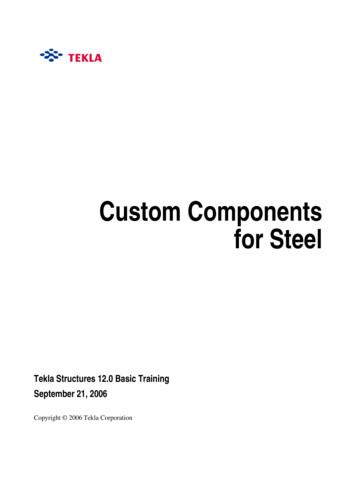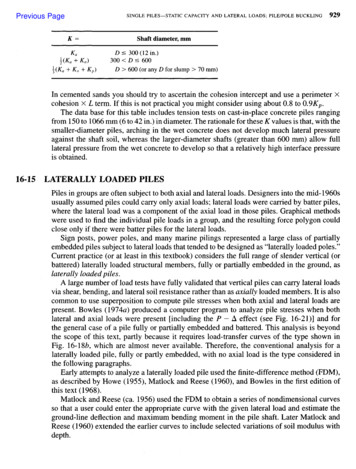Structural Component Material Selection, Design, And .
Structural Component MaterialSelection, Design, andFabricationBy: Steve Kanitz3/28/14
AbstractMaterial selection plays a vital role in the in the design and fabrication of the structuralcomponents that will be used in an electronics project. Material selection affects the cost, size,weight, strength, fabrication and assembly of the structural components to be used. The typeof material selected requires the user to also be familiar with fabrication methods for thatmaterial, since some materials can be harder and more expensive to complete the fabricationprocess on than other.IntroductionThere are three basic structural materials that will be examined in this application note; wood,steel, and aluminum. The advantages and disadvantages of using each type of material will becovered. This will include the cost, size, weight, and strength properties of each material as wellas the possible fabrication methods for each type of material as well as the advantages anddisadvantages of different of the different types of fabrication methods available for each typeof material including using hand and power tools.ObjectiveThe objective of this application is to give a detailed description of the various material andconstruction methods available for manufacturing structural components of an electronicsproject to help others decide which materials and fabrication methods will best suit theirneeds.
Using Wood as a Structural MaterialWood is one of the most basic structural components that can be used in an electronics project.It is very low cost compared to other structural materials, and 8 foot long 2x4 is around 3dollars. It is easy for those with minimal fabrication skills to manipulate safely into thestructural components they desire and it can be designed to create relatively light weightcomponents depending on the size of the structure and amount of strength or durabilityrequired in the structure being built. Some of the basic tools that can be used to fabricatewooden structures can be as simple as using a hammer and a hand saw to manipulate thematerial. It can easily be assembled using nails, screws, and glue.
More advanced tools such as power tools can be used to increase the speed and precision ofthe fabrication process. This adds slightly to the complexity of fabricating with wood asadditional skills are required to use these tools safely and effectively. Also, there is an additioncost inquired if these tools are required to be purchased to complete fabrication.The main disadvantage to using wood as a structural component is that it is relatively lowstrength per volume compared to steel and aluminum. This makes wood a good structuralcomponent to use if there is very little load to bear and size is not an issue. For stronger, moredurable structures a relatively large amount of wood would have to be used to achieve similarstrength capabilities of steel or aluminum. The size of the structure would naturally have to bemuch larger using wood. The user would then have to decide if the cost benefits of using woodoutweigh the added size of the structure by using this material.Using Steel as a Structural Material
Steel is another widely used structural component, it is much stronger than wood per volume,allowing less material to be used in a structural components design. Steel is significantly heavierthan wood though, which is one of the tradeoffs of using steel instead of wood. The maindisadvantages of using steel are the additional costs incurred by using it. Using steel to create asimilar structure to a wooden one would cost an estimated 3-5 times as much. Anotherdisadvantage to using steel as a structural component is that added complexity of fabricatingwith it. It is not easily manipulated by simple hand tools as wood is. Heavy duty power tools aretypically required to fabricate with steel, adding to the cost and skill required.Assembling a steel structure is also more complex than a wooden one. To assemble steelstructures, the pieces must be either drilled and assembled with bolts or welded together. Anadvantage to bolting pieces together is that they can be easily disassembled and reassembledto save space. Once steel is welded, it is impossible to separate the pieces without cutting themapart since they are fused together in a permanent bond. Welding can produce a lighter andmore stable structure than drilling the pieces and bolting them together. It requires the user tolearn another skill though, which is more dangerous and complex than using basic power tools.Steel also has the potential to rust. If it is going to be used outdoors or in a humid environmentit would require a coat of paint to ensure longevity of the structure produced.
Using Aluminum as a Structural MaterialThe third and final structural material that was considered to be used for our project isaluminum. It is a strong, lightweight, durable and the skills required to fabricate with it fallsomewhere between that of wood and steel. Aluminum can be manipulated much easier withhand tools than steel or it can be manipulated in many of the same manners that steel can be.The fabrication of our project structure was completed using hand tools, as well as some of thepower tools available in the machine shop available in the basement of the engineeringbuilding. The main drawback of using aluminum as a structural component as opposed to steelis that it is slightly more expensive. Aluminum is similar in strength to steel and similar in weightto wood, allowing us to use a minimal amount of material and achieve a strong, lightweight
frame for our project that still kept costs well within budget. It also does not need an paint orcoatings to protect it from the elements for maximum longevity.
Using Wood as a Structural Material Wood is one of the most basic structural components that can be used in an electronics project. It is very low cost compared to other structural materials, and 8 foot long 2x4 is around 3 dollars. It is easy for those with minimal fabrication skills to manipulate safely into the
RR Donnelley Component R.R. Donnelley Printing Companies Component Haddon Component Banta Employees Component Banta Book Group Component Banta Danbury Component Banta Specialty Converting Component Moore Wallace Component (other than Cardinal Brands Benefit and Check Printers Benefit) Cardinal Brands Benefit of the Moore Wallace Component
Since we have a custom component in the model we can open the Custom component editor. Edit custom 1. Select the User_end_plate component symbol. component 2. Right-click and select Edit custom component. The Custom component editor opens along with the Custom component editor toolbar, the Custom component browser and four views of the custom .
Note that when a new component or component update has been released that is part of the TMS Component pack, there might be some delay before the full TMS Component pack update is available that contains this new component or component update. This is due to the far more extensive testing and build procedure for the complete TMS Component Pack.
2.1 Structural Health Monitoring Structural health monitoring is at the forefront of structural and materials research. Structural health monitoring systems enable inspectors and engineers to gather material data of structures and structural elements used for analysis. Ultrasonics can be applied to structural monitoring programs to obtain such .
dinner & family style & buffet selection dinner page 3 theme buffet’s - minimum 80 pax page 4 family style selection - thai page 6 family style selection - asian / indian page 8 family style selection - european page 10 buffet selection - thai page 12 buffet selection - asian / indian page 14 buffet selection - european page 17 prices
Selection Nr.: 0 O Price set to zero Selection Nr.: 5 O Fast up Fast Increase of price or column Selection Nr.: 6 O Fast down Fast Decrease of price or column Selection Nr.: # O Copy function Copy price on next column Selection Nr.: * O Slave selection Request for slave selection Password 4 -2-3-1-4 Entry by selection button 4 key 4
SOFTWARE ENGINEERING COMPONENT LEVEL DESIGN Component level design is the definition and design of components and modules after the architectural design phase. Component-level design defines the data structures, algorithms, interface characteristics, and communication mechanisms allocated to each component for the system development.
Your sheet-pile program FADSPABW (B-9) is a special case of this method. It was separately written, although several subroutines are the same, because there are special features involved in sheet-pile design. These additional considerations would in-troduce unnecessary complexity into a program for lateral piles so that it would be a little more difficult to use. Many consider it difficult in .























